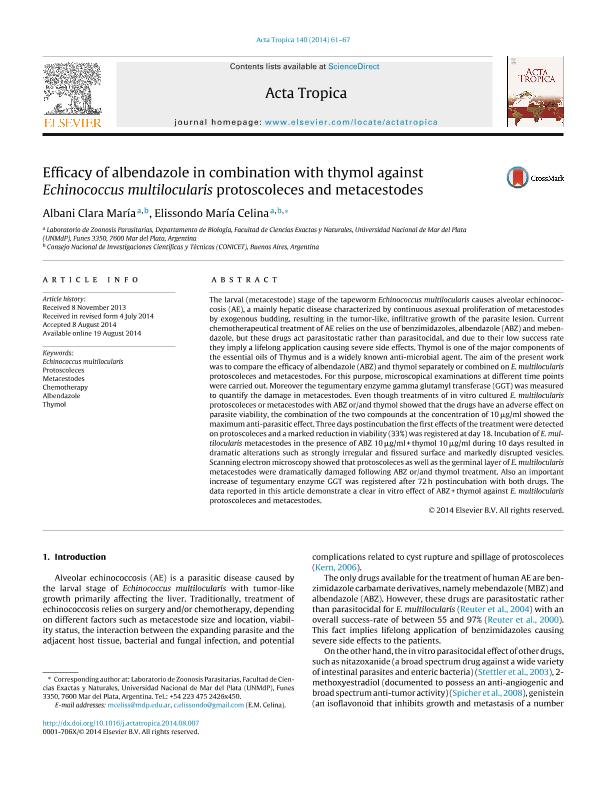Mostrar el registro sencillo del ítem
dc.contributor.author
Albani, Clara Maria

dc.contributor.author
Elissondo, María Celina

dc.date.available
2018-01-26T19:16:24Z
dc.date.issued
2014-08
dc.identifier.citation
Albani, Clara Maria; Elissondo, María Celina; Efficacy of albendazole in combination with thymol against Echinococcus multilocularis protoscoleces and metacestodes; Elsevier Science; Acta Tropica; 140; 8-2014; 61-67
dc.identifier.issn
0001-706X
dc.identifier.uri
http://hdl.handle.net/11336/34758
dc.description.abstract
The larval (metacestode) stage of the tapeworm Echinococcus multilocularis causes alveolar echinococcosis (AE), a mainly hepatic disease characterized by continuous asexual proliferation of metacestodes by exogenous budding, resulting in the tumor-like, infiltrative growth of the parasite lesion. Current chemotherapeutical treatment of AE relies on the use of benzimidazoles, albendazole (ABZ) and mebendazole, but these drugs act parasitostatic rather than parasitocidal, and due to their low success rate they imply a lifelong application causing severe side effects. Thymol is one of the major components of the essential oils of Thymus and is a widely known anti-microbial agent. The aim of the present work was to compare the efficacy of albendazole (ABZ) and thymol separately or combined on E. multilocularis protoscoleces and metacestodes. For this purpose, microscopical examinations at different time points were carried out. Moreover the tegumentary enzyme gamma glutamyl transferase (GGT) was measured to quantify the damage in metacestodes. Even though treatments of in vitro cultured E. multilocularis protoscoleces or metacestodes with ABZ or/and thymol showed that the drugs have an adverse effect on parasite viability, the combination of the two compounds at the concentration of 10 μg/ml showed the maximum anti-parasitic effect. Three days postincubation the first effects of the treatment were detected on protoscoleces and a marked reduction in viability (33%) was registered at day 18. Incubation of E. multilocularis metacestodes in the presence of ABZ 10 μg/ml + thymol 10 μg/ml during 10 days resulted in dramatic alterations such as strongly irregular and fissured surface and markedly disrupted vesicles. Scanning electron microscopy showed that protoscoleces as well as the germinal layer of E. multilocularis metacestodes were dramatically damaged following ABZ or/and thymol treatment. Also an important increase of tegumentary enzyme GGT was registered after 72 h postincubation with both drugs. The data reported in this article demonstrate a clear in vitro effect of ABZ + thymol against E. multilocularis protoscoleces and metacestodes.
dc.format
application/pdf
dc.language.iso
eng
dc.publisher
Elsevier Science

dc.rights
info:eu-repo/semantics/openAccess
dc.rights.uri
https://creativecommons.org/licenses/by-nc-sa/2.5/ar/
dc.subject
Echinococcus Multilocularis
dc.subject
Protoscoleces
dc.subject
Metacestodes
dc.subject
Chemotherapy
dc.subject
Albendazole
dc.subject
Thymol
dc.subject.classification
Otras Ciencias Biológicas

dc.subject.classification
Ciencias Biológicas

dc.subject.classification
CIENCIAS NATURALES Y EXACTAS

dc.title
Efficacy of albendazole in combination with thymol against Echinococcus multilocularis protoscoleces and metacestodes
dc.type
info:eu-repo/semantics/article
dc.type
info:ar-repo/semantics/artículo
dc.type
info:eu-repo/semantics/publishedVersion
dc.date.updated
2018-01-26T18:56:09Z
dc.journal.volume
140
dc.journal.pagination
61-67
dc.journal.pais
Países Bajos

dc.journal.ciudad
Amsterdam
dc.description.fil
Fil: Albani, Clara Maria. Consejo Nacional de Investigaciones Científicas y Técnicas; Argentina. Universidad Nacional de Mar del Plata. Facultad de Ciencias Exactas y Naturales. Departamento de Biologia. Laboratorio de Zoonosis Parasitarias; Argentina
dc.description.fil
Fil: Elissondo, María Celina. Consejo Nacional de Investigaciones Científicas y Técnicas; Argentina. Universidad Nacional de Mar del Plata. Facultad de Ciencias Exactas y Naturales. Departamento de Biologia. Laboratorio de Zoonosis Parasitarias; Argentina
dc.journal.title
Acta Tropica

dc.relation.alternativeid
info:eu-repo/semantics/altIdentifier/doi/http://dx.doi.org/10.1016/j.actatropica.2014.08.007
dc.relation.alternativeid
info:eu-repo/semantics/altIdentifier/url/https://www.sciencedirect.com/science/article/pii/S0001706X1400268X
Archivos asociados
